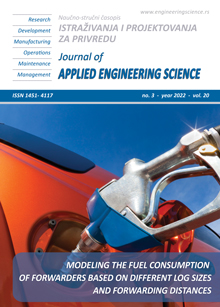ANALYSIS OF VIBRATION SIGNATURE IN DEEP GROOVE BALL BEARING USING FINITE ELEMENT METHOD
Abstract
The most common kind of bearing is the rolling element bearing, which is a used mechanical component in rotating equipment that is subjected to heavy loads and rapid rotation. Bearing failure is the main consideration in the failure of rotating hardware. A deformity at any component of the bearing transmits to every single other component, for example, external race, inward race, ball, and retainer of the bearing. The simplest way to think about ball bearing failure examination is to create counterfeit cracks of varying sizes on various components of CATIA V-6 and write down their signatures. For this reason, the vibration investigation procedure which is dependable and precisely recognizing deformity in the bearing components is utilized. Estimation of the amplitude of vibrations is carried out at 5000 RPM, a load of 200 N, and at different deformity sizes, 3 mm and 4 mm on bearing races are carried out. A preparatory vibration investigation of a rolling component is carried out using Ansys R-18.0. Vibration signals for two diverse imperfection sizes have been extricated and a file for correlation of various deformity sizes has been proposed. The impacts of radial load, rotation speed, and starting deformity size on the stress level are studied.
References
Yongqi, T. Qingchang, Z. Kuo, L. Jiangang, Analysis of Stress and Strain of the Rolling Bearing by FEA method, Phys. Procedia. 24 (2012) 19–24. doi:10.1016/j.phpro.2012.02.004.
R. Bajaj, M.E.C.A.D.C.A.M. Student, Finite Element Analysis of Integral Shaft Bearing, 3 (2015) 28–36.
C. Sharma, V. Kumar, S.C. Jain, R. Sinhasan, M. Subramanian, Study of slot-entry hydrostatic/hybrid journal bearing using the finite element method, Tribol. Int. 32 (1999) 185–196. doi:10.1016/S0301-679X(99)00032-8.
Tandon, A. Choudhury, Review of vibration and acoustic measurement methods for the detection of defects in rolling element bearings, Tribol. Int. 32 (1999) 469–480. doi:10.1016/S0301-679X(99)00077-8.
Claesson, Modelling of roller bearings in ABAQUS Master ’ s Thesis in the Applied Mechanics, (2014).
Utpat, Vibration Signature analysis of defective deep groove ball bearings by Numerical and Experimental approach, Int. J. Sci. Eng. Res. 4 (2013) 592–598.
Motooka, A finite element method used for contact analysis of rolling bearings, (2015).
G. Wei, Y.K. Liu, Finite element analysis of the roller bearing used in rolling mill, Appl. Mech. Mater. 367 (2013) 141–144. doi:10.4028/www.scientific.net/AMM.367.141.
Nabhan, Contact Stressdistribution of Deep Groove Ball Bearing Using Abaqus, J. Egypt. Soc. Tribol. 12 (2015) 49–61. doi:10.21608/JEST.2015.79986.
Xu, J. Zhang, Z. Huang, L. Wang, Calculation and finite element analysis of the temperature field for high-speed rail bearing based on vibrational characteristics, J. Vibroengineering. 17 (2015) 720–732.
Amarnath, R. Shrinidhi, a Ramachandra, S.B. Kandagal, Prediction of Defects in Antifriction Bearings using Vibration Signal Analysis, Time. (2004) 88–92.
Gopalakrishnan, R. Murugesan, Contact Analysis of Roller Bearing Contact Analysis of Roller Bearing Using Finite Element, Vels J. Mech. Eng. 2 (2015) 1–5.
Azad, K. Ramji, T.N. Officer, Identification of bearing assembly defects using Finite Element Analysis and Condition Monitoring Techniques, 1 (2012) 1–13.
Deng, Y. Guo, A. Zhang, S. Tang, Finite element analysis of thrust angle contact ball slewing bearing, IOP Conf. Ser. Mater. Sci. Eng. 274 (2017). doi:10.1088/1757-899X/274/1/012096.
Shao, W. Tu, F. Gu, A simulation study of defects in a rolling element bearing using FEA, ICCAS 2010 - Int. Conf. Control. Autom. Syst. (2010) 596–599. doi:10.1109/iccas.2010.5669813.
Saruhan, S. Saridemir, A. Çiçek, I. Uygur, Vibration analysis of rolling element bearings defects, J. Appl. Res. Technol. 12 (2014) 384–395. doi:10.1016/S1665-6423(14)71620-7.
T. Ravindra, K.K. Nilesh, M. P.Shyam, Vibration analysis of ball bearing, Int. J. Sci. Res. 4 (2015) 2655–2665. https://www.ijsr.net/archive/v4i5/SUB154835.pdf.>
R. D, P.S.S. Kulkarni, Vibration Analysis of deep groove ball bearing using Finite Element Analysis, 5 (2015) 44–50.
SKF 6202 Deep groove ball bearings, (2021) 3–6.
Tyagi, S.K. Panigrahi, Transient Analysis of Ball Bearing Fault Simulation using Finite Element Method, J. Inst. Eng. Ser. C. 95 (2014) 309–318. doi:10.1007/s40032-014-0129-x.
Huang, Z. Yuan, W. Kang, Z. Xue, X. Chen, C. Yang, Y. Ye, J. Leng, Study of the sealing performance of tubing adapters in gas-tight deep-sea water sampler, Int. J. Nav. Archit. Ocean Eng. 6 (2014) 749–761. doi:10.2478/IJNAOE-2013-0212.
B. Davanageri, S. Narendranath, R. Kadoli, Finite Element Wear Behaviour Modeling of Super duplex stainless steel AISI 2507 Using Ansys, IOP Conf. Ser. Mater. Sci. Eng. 376 (2018). doi:10.1088/1757-899X/376/1/012131.
Gardner, The use of stainless steel in structures, Prog. Struct. Eng. Mater. 7 (2005) 45–55. doi:10.1002/pse.190.

